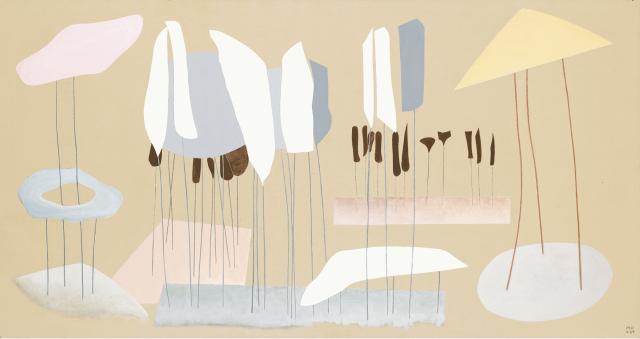Clouds, which are depicted in the painting Grosser Himmel mit Wolken über Kontinenten (Large Sky with Clouds over Continents, 1964), are a recurring theme in Meret Oppenheim’s work. Interpreted through various techniques, here they occupy the pictorial space of this large canvas without any vanishing point, nor any perspective beyond the accumulation and arrangement of shapes one behind the other.
This major piece stands as one of the most accomplished in the artist’s thematic body of work. This subject appeared the same year in Drei Wolken über Kontinent (1964), which presented a similar composition. The cumuli, frozen in their continuous advance, take on the appearance of gracious, light silhouettes, connected to their terrestrial base by a fine line. Their sudden immobility contrasts with their inherent weightlessness in a mellow chromatic palette.
Here, there is an alternation between rounded and angular shapes, between verticality and horizontality, in a poetical atmosphere skillfully brought to life by the artist. In 1966, for this same motif, the artist abandoned irregular contours in favor of more geometric symbols like circles and squares in Zwei Gestirne ziehen hinter Wolken.
From 1953, Meret Oppenheim’s clouds conveyed an extremely wide range of expressions, and were even transposed into three dimensions, materialized in bronze.
Meret Oppenheim drew other subjects from metamorphosing nature: like the butterfly, stars, and even fog, various motifs that she explored in order to understand the constant transformation of our cosmos.
This major piece stands as one of the most accomplished in the artist’s thematic body of work. This subject appeared the same year in Drei Wolken über Kontinent (1964), which presented a similar composition. The cumuli, frozen in their continuous advance, take on the appearance of gracious, light silhouettes, connected to their terrestrial base by a fine line. Their sudden immobility contrasts with their inherent weightlessness in a mellow chromatic palette.
Here, there is an alternation between rounded and angular shapes, between verticality and horizontality, in a poetical atmosphere skillfully brought to life by the artist. In 1966, for this same motif, the artist abandoned irregular contours in favor of more geometric symbols like circles and squares in Zwei Gestirne ziehen hinter Wolken.
From 1953, Meret Oppenheim’s clouds conveyed an extremely wide range of expressions, and were even transposed into three dimensions, materialized in bronze.
Meret Oppenheim drew other subjects from metamorphosing nature: like the butterfly, stars, and even fog, various motifs that she explored in order to understand the constant transformation of our cosmos.
